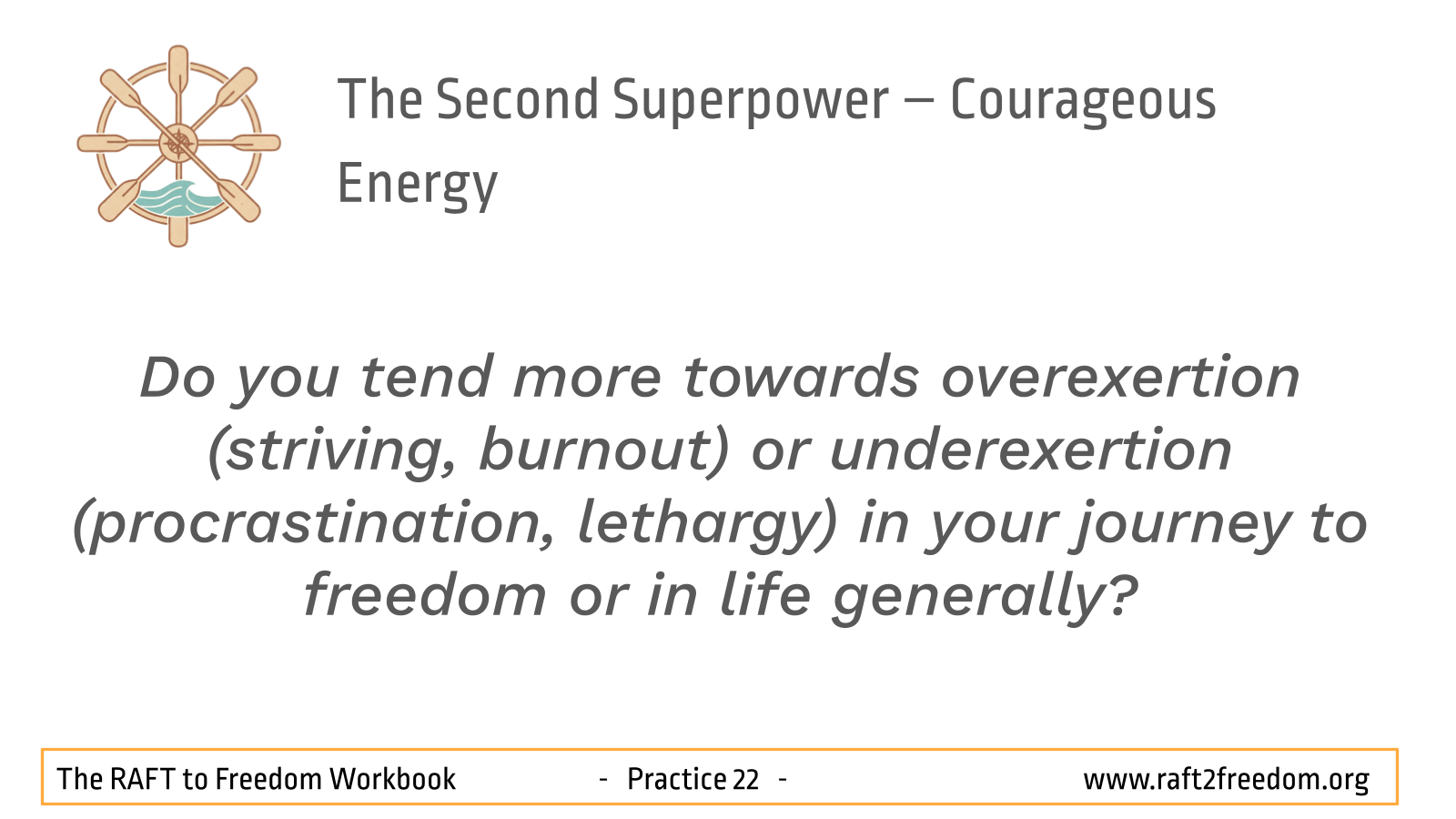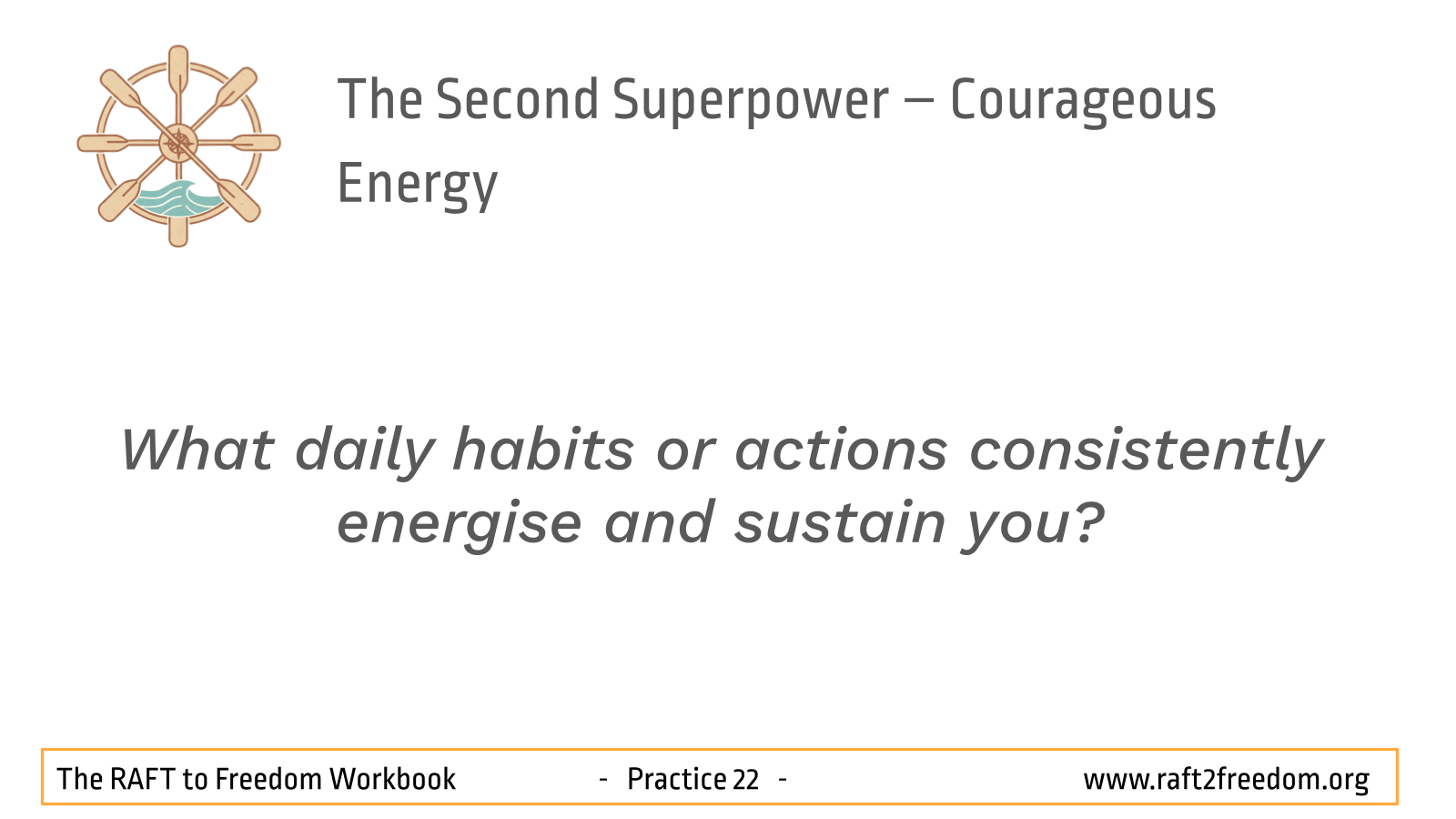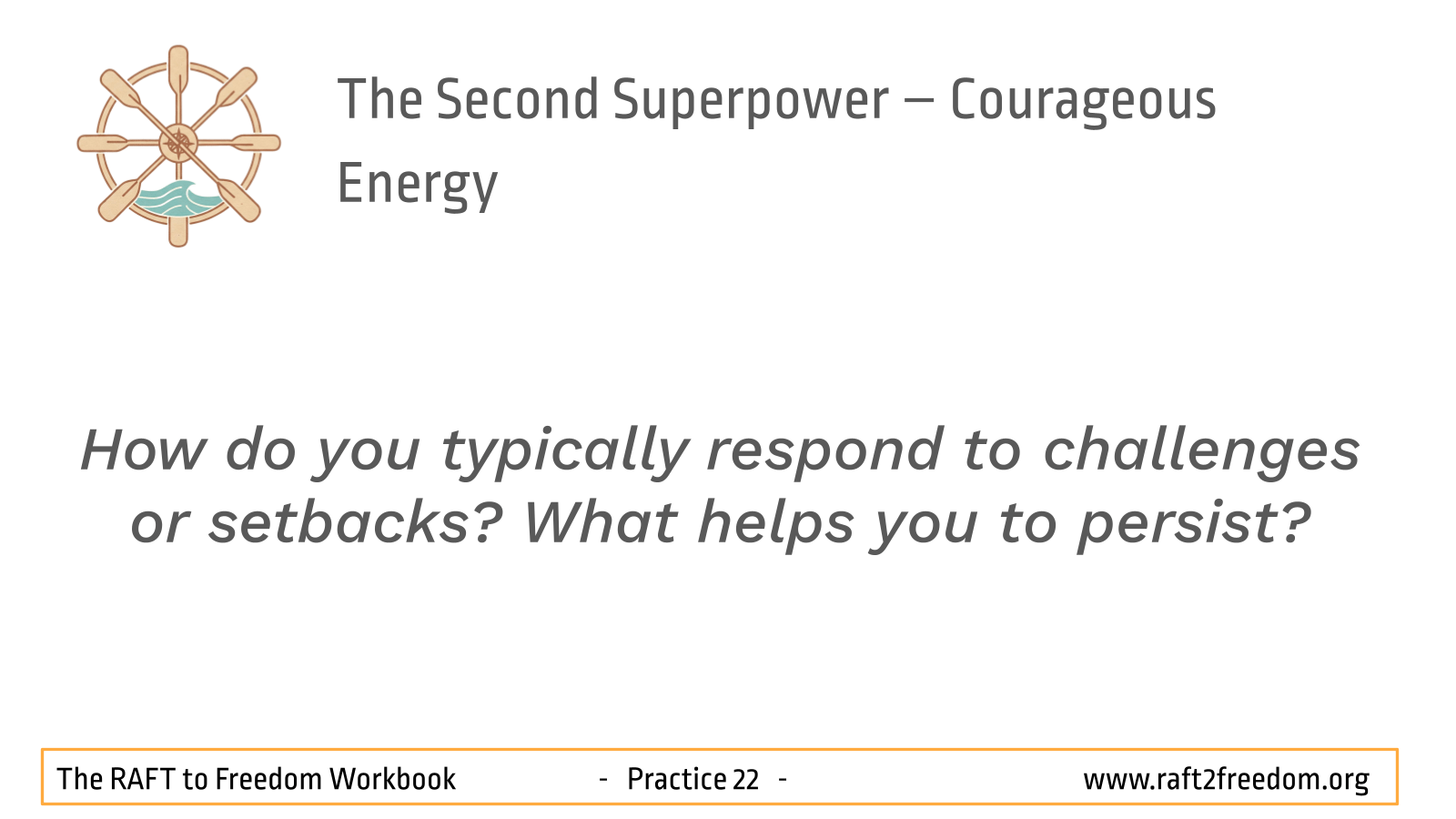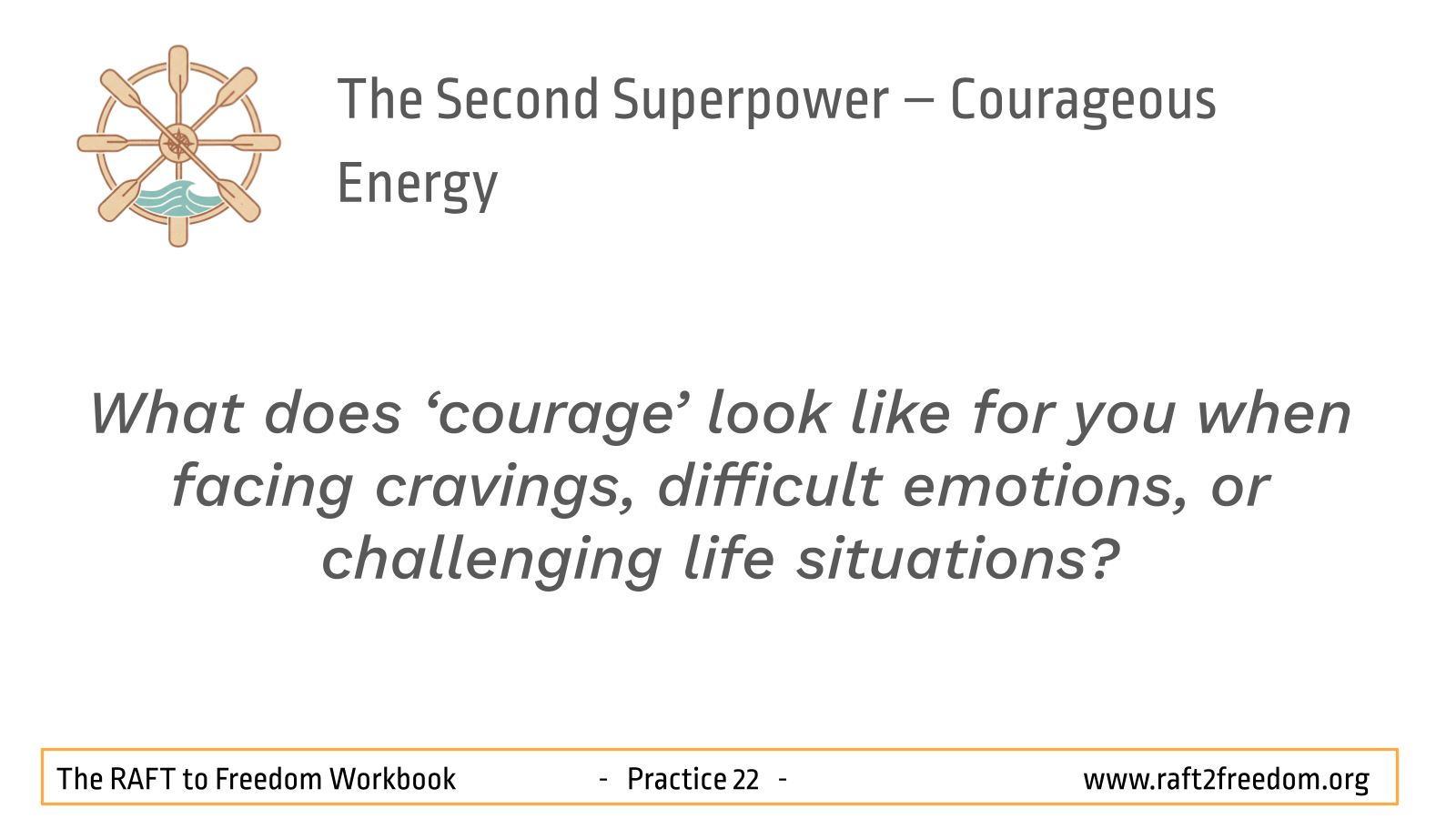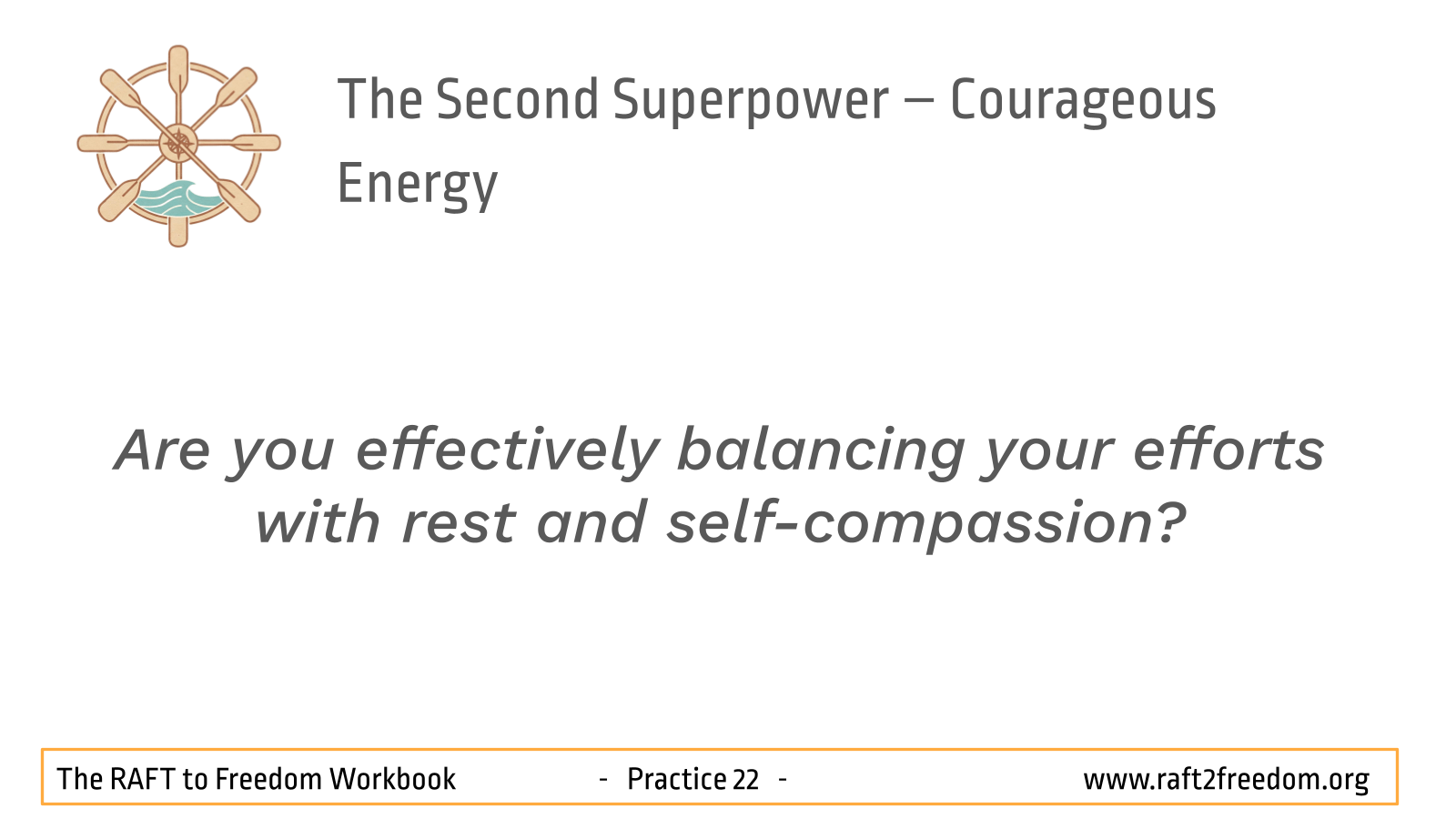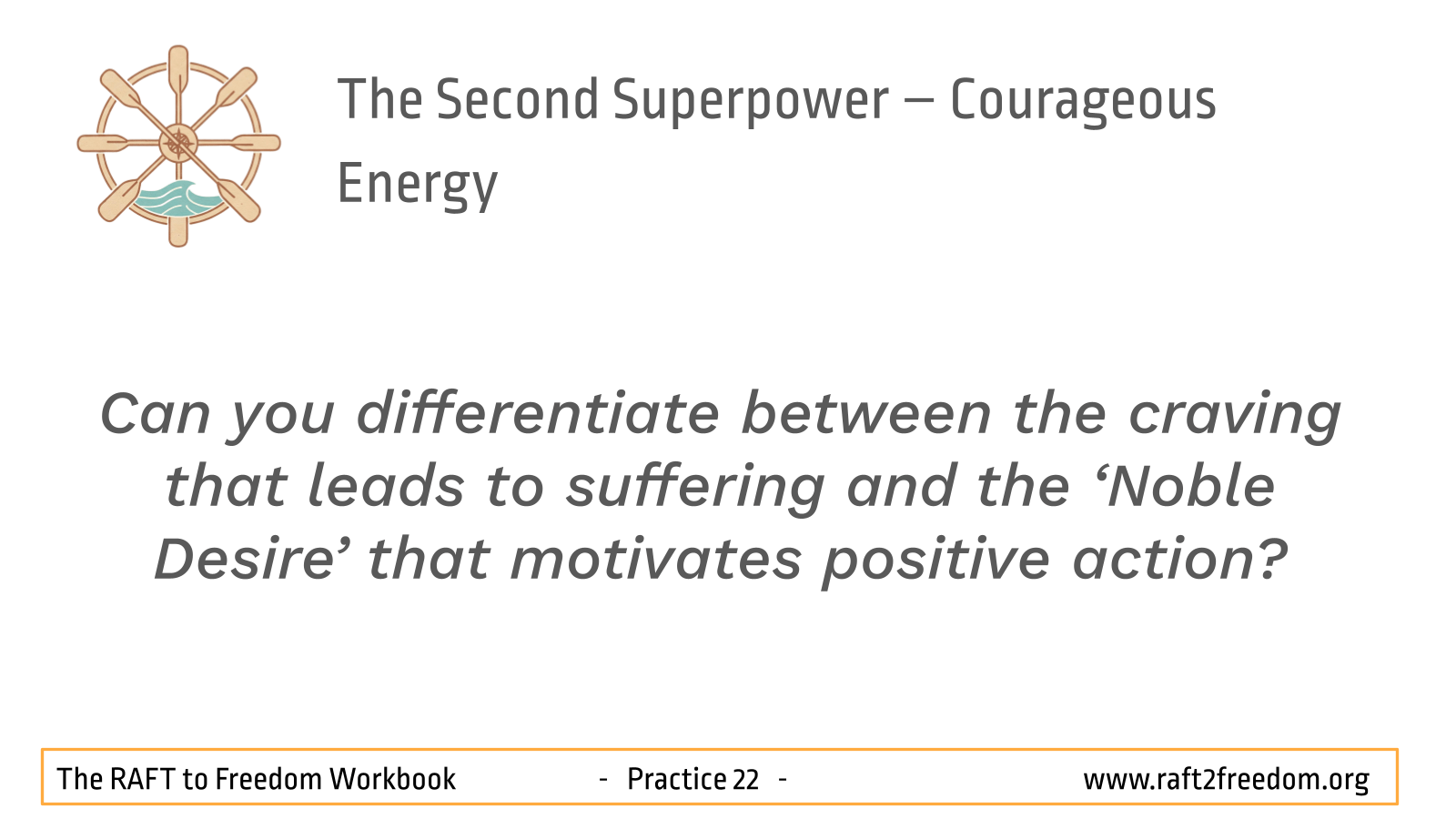22 – The Second Superpower – Courageous Energy
The steady power propelling our raft
Better than a hundred years lived in idleness and in weakness is one day lived with courage and powerful striving.
Gotama (the Buddha)
Courage is the most important of all the virtues, because without courage, you can’t practise any other virtue consistently.
Maya Angelou

Episode 22 – Courageous Energy as a superpower
An AI generated ‘deep dive’ into this aspect of the RAFT to Freedom
Having explored ‘Noble Desire’ as the crucial spark, the wholesome aspiration and committed interest that ignites and fuels our journey. We now explore the second of the ‘Four Superpowers’ needed for our journey to liberation: Courageous Energy (or Effort). If ‘Noble Desire’ is the aspiration and commitment that points us towards the safe shore, then ‘Courageous Energy’ is the persistent, balanced, and courageous effort we need to actually propel our raft across the water. Courageous Energy is the dependable power source of our raft, steadily propelling us from the dangerous shore of suffering towards the safe shore of freedom. It’s the force that translates our resolves into sustained action – the persistent paddling we need to cross the water, especially when we are rowing against the strong currents of craving or the doldrums of apathy.
Effort (viriya) is a cornerstone of Buddhist practice, so much so that it appears in many different guises that we will be exploring in future chapters including the ‘Five Defences’, ‘Seven Supports’ and the ‘Land of the Middleway’. Its frequent appearance underscores its vital importance. Within our presentation of the Four Superpowers, we are framing it as “Courageous Energy’.
The Buddhist teacher and author Martine Batchelor emphasises:
Great courage is going beyond our usual patterns… courage is also suddenly thinking that this is possible.
Courageous Energy isn’t about our frantic, white-knuckled striving or aggressive force. True Courageous Energy possesses several key qualities:
- Courage: It takes great courage for us to face our discomfort, challenge our old habits, admit our vulnerabilities, and to persist when things are difficult. Maya Angelou noted that courage enables all the other virtues.
- Persistence: Our journey to liberation is a ‘marathon, not a sprint’. Courageous Energy is the quality that keeps us ‘coming back’ – to meetings, to our practice, to skillful choices – day after day, even when our motivation fluctuates. I
- Balance: Crucially, Courageous Energy must be balanced. Gotama famously used the simile of tuning a lute: if the string is too tight, it snaps; if too loose, it makes no sound. Skillful Courageous Energy finds the middle path between our over-straining (leading to burnout, anxiety) and slackness (leading to complacency, inertia). In the words of the monastics at Wat Suan Mokkh in Thailand, ‘Not too sergeant major and not too mashed potato!’.
Being aware of our patterns of energy expenditure – where we apply effort readily, where we hold back, where we push too hard – is part of the first stage of our journey, which is to recognise what it is to be human and how things really are. We also recognise our inherent capacity for this balanced, courageous effort.
In our RAFT to Freedom metaphor, Courageous Energy is the steady supply of fuel and the consistent power output that propels our raft. It ensures our raft doesn’t just drift but makes consistent progress towards the safe shore, powered by the spark of Noble Desire.
How to cultivate Courageous Energy
Cultivating balanced, sustained effort involves conscious practices that we integrate consistently into our daily lives:
- Apply consistent, manageable effort: Our journey to freedom thrives on regular, sustainable actions rather than sporadic, intense bursts. Small, consistent efforts (daily meditation, journaling, support meetings, therapeutic practices) build momentum and enduring resilience. This consistent application of effort is how Courageous Energy helps us overcome unwholesome and unhelpful states and cultivate more wholesome ones.
- Balance your energy (the Middle Way): Skillfully balance activity and rest, effort and ease. Learn to tune your effort like the lute string. Recognise early signs of burnout such as fatigue or irritability, and practise self-compassion by adjusting your effort accordingly. Notice signs of complacency or lethargy and gently apply energy to re-engage these. An ‘Energy Audit’ –checking where your energy is going, can be helpful.
- Direct energy towards the ‘Four Resolves’: Apply Courageous Energy specifically towards the ‘Four Resolves’: Preventing, Abandoning, Cultivating and Maintaining. Ensure your effort serves your wellness goals, including cultivating wholesome states to replace harmful patterns, and rebuilding relationships and contributing positively to other people’s lives.
- Meet obstacles with resilience and courage: Use Courageous Energy not to aggressively fight against challenges (cravings, setbacks, difficult emotions), but to meet them with fearlessness and persistence. Approach setbacks and challenges as ‘plot twists’ – opportunities to learn and grow. Rather than resisting difficulties, courageously embrace them with curiosity and adaptability. As Thich Nhat Hanh said:
- “No mud, no lotus. Without suffering, there’s no happiness. Don’t run away from your suffering. Embrace it and transform it.“.
- And Viktor Frankl reminds us, when we are no longer able to change a situation, we are challenged to change ourselves, which requires inner heroic effort.
- Connect effort with Noble Desire: Regularly reconnect your Courageous Energy with your deeper aspirations and values. Reminding yourself of the reasons behind your effort sustains your motivation and resilience through the fluctuations of daily life. This consistent effort to cultivate wholesome desire for healing and change is a key aspect of how Courageous Energy supports Noble Desire in our journey to freedom.
A practical application: a weekly Courageous Energy action plan
- Day 1 – Conduct an energy audit
- Review how and where your physical, emotional, and mental energy is being spent.
- Reflection: What activities drain or replenish you? What’s worth your energy?
- Day 2 – Set one small, balanced effort goal
- Choose a simple, meaningful action that supports your healing or growth.
- Reflection: How can I engage fully without pushing too hard or holding back?
- Day 3 – Practise mindful ‘effort scaling’
- Pay attention to how much effort you apply in different moments.
- Reflection: Did I overexert or under-commit? What adjustment might help?
- Day 4 – Face a Challenge Courageously
- Approach something you find uncomfortable with presence and resolve.
- Reflection: What helped you engage? What did you learn about your capacity?
- Day 5 – Daily dedication of focused intention
- Begin the day by naming your intention and applying it to one key task.
- Reflection: What impact did this have? What might you tweak tomorrow?
- Day 6 – Connect with inspiring resources
- Engage with something uplifting: a teaching, story, quote, or conversation.
- Reflection: How did this spark your motivation or renew your courage?
- Day 7 – Log your momentum
- Ensure to write in your journal a record of your steady, meaningful effort.
- Reflection: What progress can you celebrate? Where are you seeing growth?
Self-reflections
Consider your personal relationship with courageous energy:
- Do you tend more towards overexertion (striving, burnout) or underexertion (procrastination, lethargy) in your journey to freedom or in life generally?
- What daily habits or actions consistently energise and sustain you?
- How do you typically respond to challenges or setbacks? What helps you to persist?
- What does ‘courage’ look like for you when facing cravings, difficult emotions, or challenging life situations?
- Are you effectively balancing your efforts with rest and self-compassion?
Journaling prompts
Use writing to explore and cultivate Courageous Energy.
- The lute string: Reflect on the lute simile. Where in your life (healing practices, work, relationships) might your effort be too tight (strained)? Where might it be too loose (slack)? What would a more balanced approach look like in one of these areas?
- Obstacle strategy: Identify one common challenge or obstacle you face on your journey to freedom (for example, a specific trigger, a recurring negative thought, social pressure). Brainstorm a strategy for meeting this challenge with courageous, balanced effort next time it arises.
- Daily courage intention: Set a daily, achievable goal requiring balanced effort. At the start of your day, set one small, specific intention related to applying Courageous Energy skilfully (for example, ‘Today, I will make the effort to practice mindful breathing for 5 minutes’, ‘Today, I will courageously face one small task I’ve been avoiding’). At the end of the day, reflect briefly on how it went. Reflect on how this small daily commitment influences your overall well-being.
- Consistent momentum: Keep a simple log for a week, noting down one small, consistent action you took each day that supports your journey to liberation. Acknowledge the effort involved, however small, to build a sense of momentum. Reflect weekly on the cumulative benefits (see the weekly Courageous Energy action plan above).
Supporting material: scientific and philosophical perspectives
To further ground our understanding of Courageous Energy, we can look to insights from contemporary science and ancient philosophy, which echo the wisdom of Gotama’s insights:
The importance of balanced, persistent effort is widely recognised:
- Neuroscience: Steady, consistent effort strengthens neural pathways in the prefrontal cortex responsible for sustained focus, emotional regulation, and goal-directed behaviour. Sustained effort and attention rely on executive functions mediated by the prefrontal cortex (PFC). Consistent practice strengthens these circuits, supporting emotional resilience and persistence. Managing energy involves complex neurochemistry (dopamine for motivation, serotonin/norepinephrine for alertness/fatigue). Chronic stress can deplete resources and impair PFC function, highlighting the need for balanced effort and stress management. Resilience research explores the neural basis for persisting through adversity.
- Psychology: Dialectical Behaviour Therapy (DBT) highlights distress tolerance and balanced effort as critical for sustainable well-being and long-term liberation. Grit, defined by Angela Duckworth as passion and perseverance for long-term goals, strongly correlates with achievement and well-being. Self-regulation theories study the capacity for effortful control over impulses and sustained goal pursuit. Behavioural Activation emphasises that consistent action, even without initial motivation, can shift mood and build momentum. Research on burnout highlights the dangers of excessive, unbalanced effort. Self-efficacy (belief in one’s ability) is built through persistent effort and overcoming challenges.
- Philosophy: Virtue ethics emphasises the importance of persistent, purposeful effort in cultivating a meaningful life. Virtue ethics emphasises cultivating virtues like courage (fortitude) and perseverance through consistent practice. Stoicism champions endurance, resilience, and focusing effort on virtuous action despite external difficulties. Existentialism stresses the importance of commitment and action in creating a meaningful life despite inherent challenges. Many traditions value discipline not as rigid punishment, but as skillful training requiring sustained effort.
Remember to remember
Courageous Energy is the second essential superpower, providing the sustained fuel and driving force for our RAFT to Freedom. Ignited by Noble Desire, it empowers us to act consistently, face challenges with resilience, and persist on the path even when motivation wavers. Recognising our capacity for this balanced, determined effort is a key part of the first stage of our journey. Remember the wisdom of the lute string – find the balance between striving and slackness. Nurture your energy with self-compassion, celebrate small steps, and keep coming back to your practice and your purpose. With aspiration providing us with direction (Noble Desire) and energy providing momentum (Courageous Energy), we now turn to the superpower that keeps our mind steady and focused on the task at hand – the Heart’s Compass.
Brené BrownYou can choose courage or you can choose comfort, but you cannot choose both.
Courage doesn’t always roar. Sometimes courage is the quiet voice at the end of the day saying, ‘I will try again tomorrow.’
Mary Anne Radmacher
Sutta references
- Iddhipāda-vibhaṅga Sutta (SN 51.20): Defines Courageous Energy (Viriya) as foundational to spiritual power and goal achievement.
- Summary: Explains the base of power endowed with concentration founded on energy (Viriya) and volition, crucial for achieving goals.
- Sona Sutta (AN 6.55): Uses the lute-string analogy to teach balanced, effective effort.
- Summary: The Buddha advises the monk Sona, who was striving too intensely, to balance his energy like tuning a lute—not too tight, not too loose—for sustainable and effective practice.
- Dhammapada Verse 112: Praises sustained courage and effort as essential virtues for meaningful living.
- Summary: States that a single day lived with energy and determination is better than a hundred years lived in laziness and weakness.
- Viriya Indriya/Bala Suttas (SN 48.10 / AN 5.14): Define Viriya as a spiritual faculty and power.
- Summary: Describe Viriya as the energy exerted for abandoning the unskilful and cultivating the skilful, characterized by persistence and not giving up the task. As a power (Bala), it makes one unshakable by laziness.
- Sammappadhana Suttas (SN 45.8, AN 4.13/14): Define Right Effort, which is synonymous with skilful Viriya.
- Summary: Outline the Four Right Efforts (Preventing, Abandoning, Cultivating, Maintaining) as the practical application of Viriya on the path.
RAFT to Freedom © 2025 by Dr Cathryn Jacob and Vince Cullen is licensed under CC BY-NC-SA 4.0. To view a copy of this license, visit https://creativecommons.org/licenses/by-nc-sa/4.0/ |
